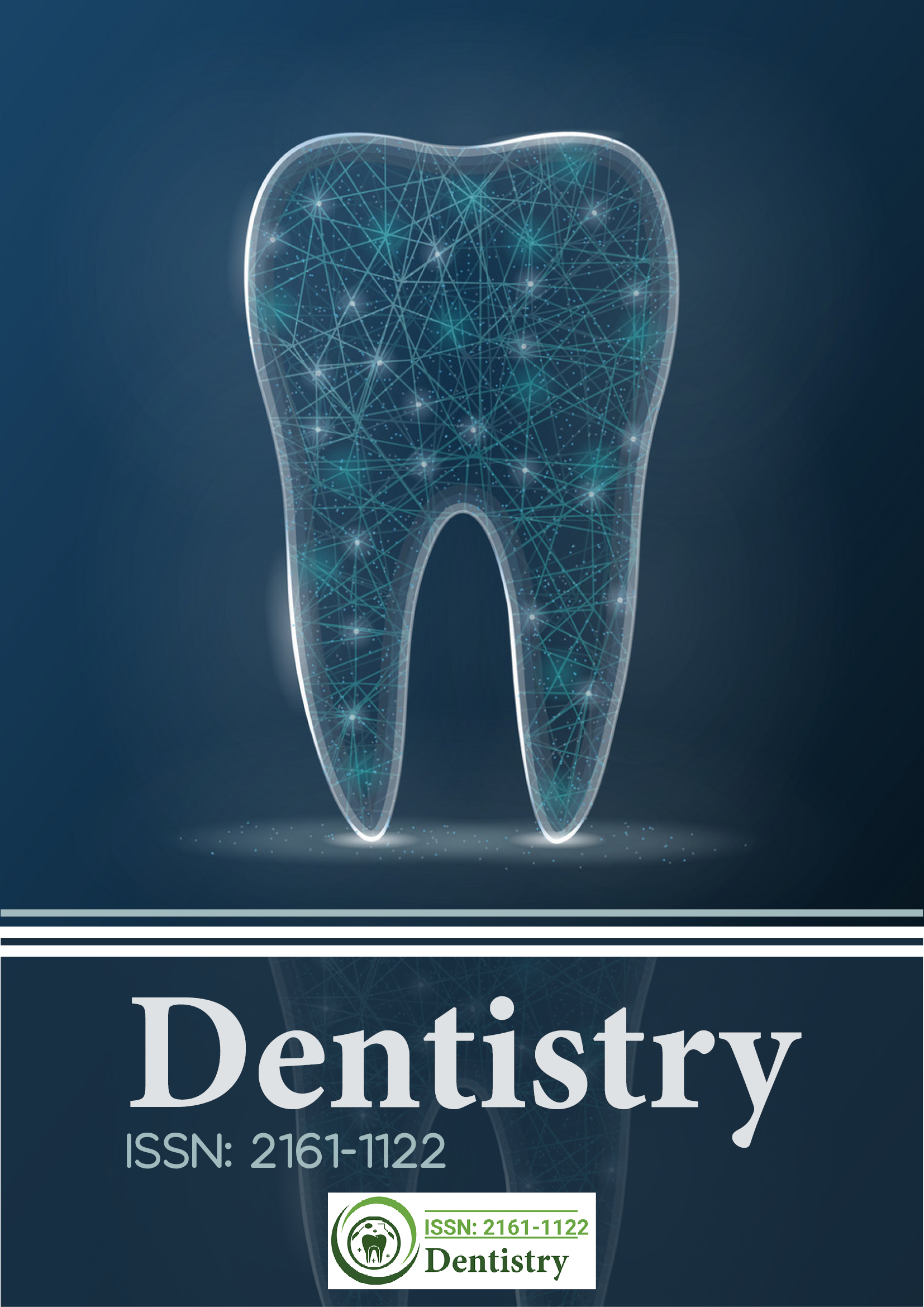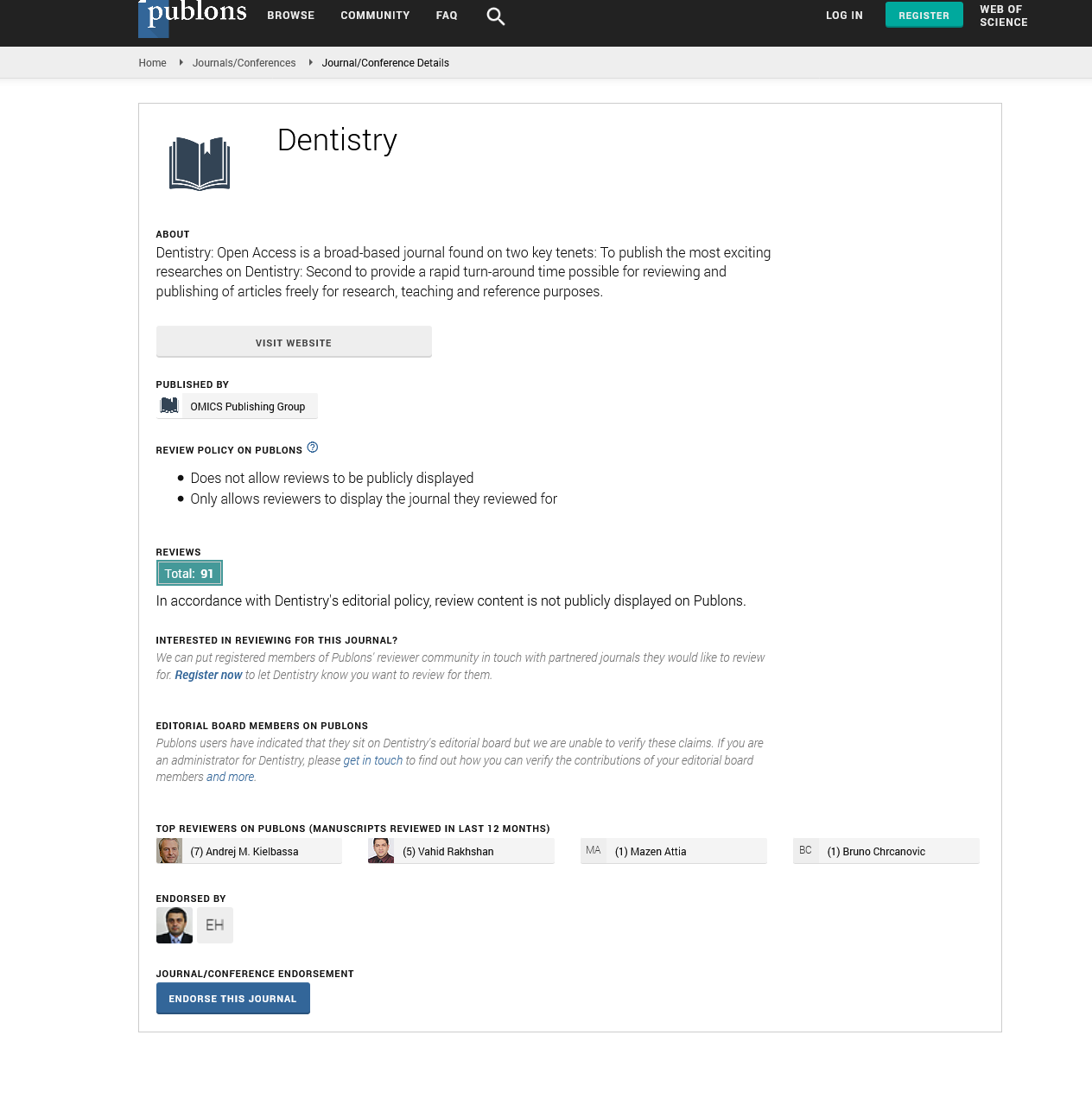Citations : 2345
Dentistry received 2345 citations as per Google Scholar report
Indexed In
- Genamics JournalSeek
- JournalTOCs
- CiteFactor
- Ulrich's Periodicals Directory
- RefSeek
- Hamdard University
- EBSCO A-Z
- Directory of Abstract Indexing for Journals
- OCLC- WorldCat
- Publons
- Geneva Foundation for Medical Education and Research
- Euro Pub
- Google Scholar
Useful Links
Share This Page
Journal Flyer

Open Access Journals
- Agri and Aquaculture
- Biochemistry
- Bioinformatics & Systems Biology
- Business & Management
- Chemistry
- Clinical Sciences
- Engineering
- Food & Nutrition
- General Science
- Genetics & Molecular Biology
- Immunology & Microbiology
- Medical Sciences
- Neuroscience & Psychology
- Nursing & Health Care
- Pharmaceutical Sciences
Commentary Article - (2022) Volume 12, Issue 5
Rapid Developments in the Field of Dental Implants
Mustafa Negar*Received: 02-May-2022, Manuscript No. DCR-22-17025; Editor assigned: 06-May-2022, Pre QC No. DCR-22-17025 (PQ); Reviewed: 20-May-2022, QC No. DCR-22-17025; Revised: 30-May-2022, Manuscript No. DCR-22-17025 (R); Published: 07-Jun-2022, DOI: 10.35248/2161-1122.22.12.577
Description
The discipline of implant dentistry is constantly evolving, with novel breakthroughs occurring on a daily basis. Implant dentistry has evolved into an evidence-based clinical science since the late twenty-first century. The prosthetic replacement of missing teeth, they are today considered the gold standard in dentistry. A dental implant is a surgical device that is inserted into the jawbone and gradually integrates with the bone. A dental implant is a prosthetic tooth root that is used to replace the root of a missing tooth. This "artificial tooth root" then holds a new tooth or bridge in place. A dental implant fused to the jawbone is the closest thing to a natural tooth since it stands alone without impacting surrounding teeth and is extremely stable.
The process of the dental implant and the jawbone fusing together is referred to as osseo integration. The majority of dental implants are made of titanium, which allows them to merge with bone without being recognised as a foreign object in our body. Dental implants, on the other hand, now have a success rate of about 98%. When a dental surgeon evaluates the area to be evaluated for a dental implant and does a clinical evaluation to see if the patient is a good candidate for one. There are numerous benefits to choosing a dental implant over alternative tooth replacement methods. Dental implants are generally conservative in the sense that they can replace lost teeth without damaging or modifying the neighboring teeth. Dental implants are also incredibly stable and can approximate the appearance and feel of real teeth because they are placed in the bone.
The biological surface features of the implant surface have been researched and exploited to increase osseo integration. Various methods have been used to improve the surface roughness of implants, including machining, plasma spray coating, grit blasting, acid etching, Sandblasted (SLA), anodizing, and biomimetic coating. Surface roughness, which exhibits enhanced osteoblast activity at 1 m to 100 m of surface roughness relative to a smooth surface, is a critical determinant in implant osseo integration. Rough surfaces are thought to have greater osseo integration than smooth surfaces, but research findings are mixed, and it's unclear if several treatments produce superior predictive outcomes.
The first-generation implant surface design with a turned surface implant is the machined implant surface. By spraying a substance dissolved in heat on the surface of the implant, plasma spray coating creates a thick layer of deposition such as Hydroxyapatite (HA) and titanium. Grit-blasting is a technique that involves spraying ceramic or silica particles onto the implant's surface. Acid etching is used to remove the leftover blasting particles, which can be sand, HA, alumina, or titanium dioxide (TiO2) particles. Acid-etching is the process of roughening titanium implant surfaces with strong acids such hydrofluoric acid (HF), nitric acid (HNO3), sulfuric acid (H2SO4), or mixtures of these acids. After sandblasting with 250 m-500 m big grit particles, SLA is acid etching. Anodizing is the dielectric breakdown of the TiO2 layer caused by a micro-arc created by increasing the voltage. On the titanium surface, this action creates a porous layer.
SLA, HA coating, and oxidized surface changes were reported to have a 100% survival rate in the short term, while the survival rate tended to be slightly reduced in the long term. SLA had a 10-year survival rate of 98.8997%, while Titanium Plasma- Sprayed (TPS) had a 20-year survival rate of 89.5%. At 8-12 years of follow-up, the survival rate with anodizing was 96.5%-100%. Although the survival rate with HA coating was as low as 82.0% at a 10-year follow-up in recent, there was also a report of 98.5% and 93.2%, which was similar to uncoated titanium implants.
Citation: Negar M (2022) Rapid Developments in the Field of Dental Implants. J Dentistry. 12:577.
Copyright: © 2022 Negar M. This is an open access article distributed under the terms of the Creative Commons Attribution License, which permits unrestricted use, distribution, and reproduction in any medium, provided the original author and source are credited.

